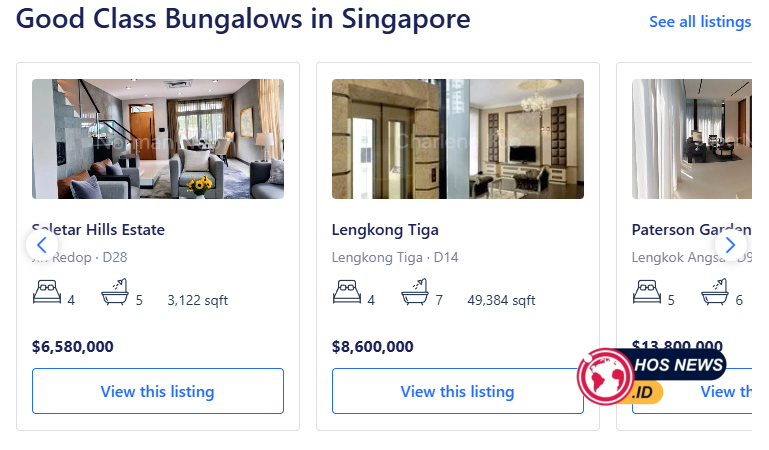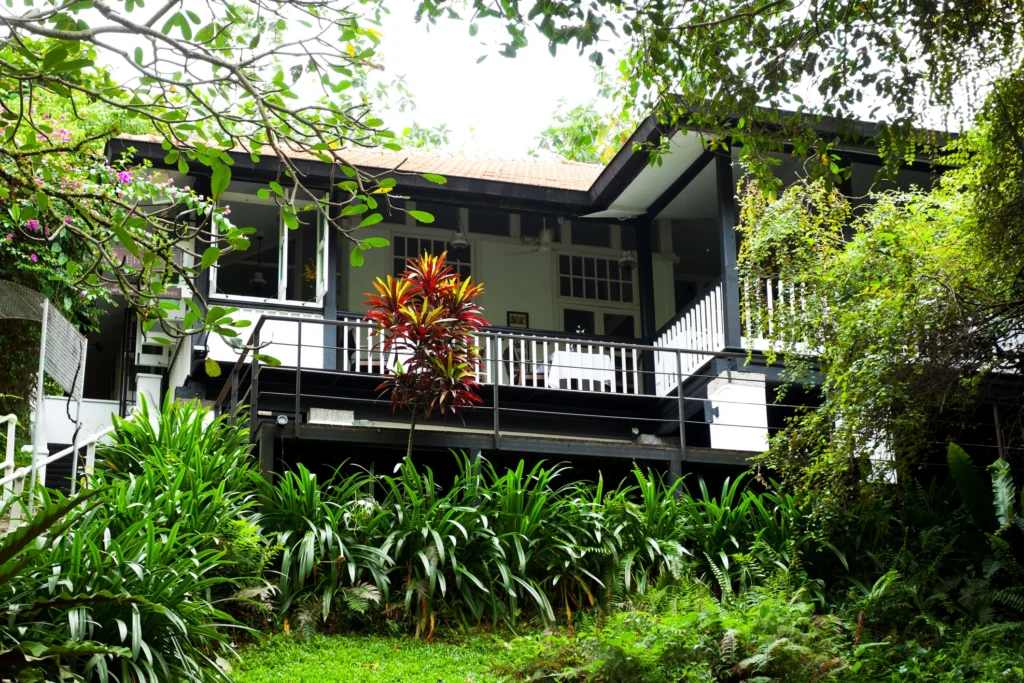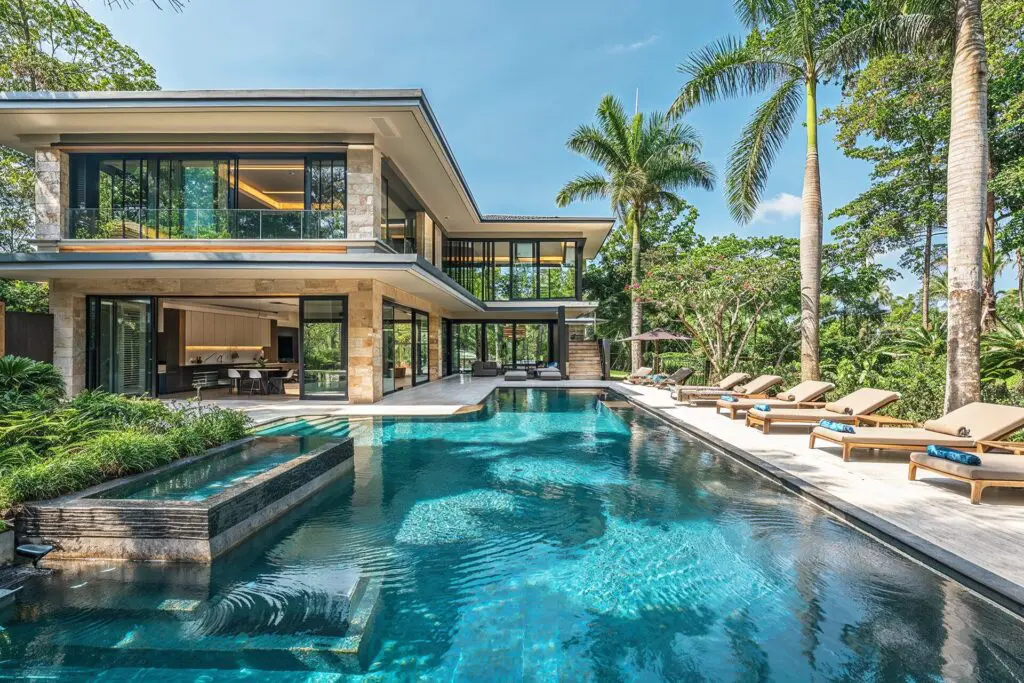What is a Good Class Bungalow (GCB) in Singapore? : Good Class Bungalow in Singapore epitomize luxury living in this vibrant city-state, embodying elegance, exclusivity, and luxury.
Nestled within prestigious neighbourhoods such as Bukit Timah, Nassim, and Sentosa Cove, these expansive properties
Good Class Bungalow in Singapore have long been seen as a status symbol in Singapore, and many near-mythical qualities are associated with them.
People whisper about how their values never fall, how every single one is like a gold mine, and how the government will never demolish them.
Really? This begs the question: Do we put too much stock in GCBs, and why are they such a big deal?
Baca Juga : 16# Contoh Desain Interior Rumah Minimalis & Modern Terbaik
What is a Good Class Bungalow in Singapore?

There are 586 Good Class Bungalows for Sale. You can use our Elegant Property Search Tool to find the right New Project Launch and other resale properties with detailed information, including maps and photos. The options in our
The Good Class Bungalow in Singapore, commonly called GCB, is at the top end of Singapore’s residential property market.
To qualify as a GCB, the property must have at least 1,400 square metres (approx. 15,070 sq.ft.) of land area, and the bungalow is limited to a maximum of two storeys in height.
That’s not all: The GCB must also be located in the prime residential districts of 10 and 11 or the bungalow estates of districts 20, 21, and 23 within these 39 Good Class Bungalow Areas (GCBAs):
- Belmont Park
- Bin Tong Park
- Binjai Park
- Brizay Park
- Bukit Sedap
- Bukit Tunggal
- Caldecott Hill Estate
- Camden Park
- Chatsworth Park
- Chee Hoon Avenue
- Chestnut Avenue
- Cluny Hill
- Cluny Park
- Cornwall Gardens
- Dalvey Estate
- Eng Neo Avenue
- Ewart Park
- First / Third Avenue
- Ford Avenue
- Fourth / Sixth Avenue
- Gallop Road / Woolerton Park
- Garlick Avenue
- Holland Park
- Holland Rise
- Kilburn Estate
- King Albert Park
- Leedon Park
- Maryland Estate
- Nassim Road
- Oei Tiong Ham Park
- Queen Astrid Park
- Raffles Park
- Rebecca Park
- Ridley Park
- Ridout Park
- Swiss Club Road
- Victoria Park
- White House Park
- Windsor Park
Combined, it’s estimated that there are roughly 2,800 GCB land plots in Singapore. Note that it’s often said that there are around 2,800 GCBs, but this needs to be more accurate, as a single plot may have more than one bungalow. GCB plots may also be subdivided if the resulting land area of the separate plots is still 1,400 square metres or above.
There are also GCB properties with land plots below 1,400 square metres in the GCB areas established before the authorities began gazetting GCB areas some 40 years ago; these properties are still counted as GCBs.
There is also a subset of GCBs that are specially conserved bungalows, such as black-and-white houses. Only 65 of these are, and their facades cannot be changed. These GCBs are typically owned and rented out by the state, and any renovations, expansions, etc., must be approved by the government first.
GCBs are quite easily recognised from the size of their estate grounds. This isn’t because the owners want to show off their huge gardens. Some do, but it has more to do with the built-up area (i.e. the bungalow itself), which cannot take up more than 35% of the total plot when being built. (If this wasn’t a rule, we’re sure some GCB homeowners would build a garage for ten cars, ruining the aesthetics of a GCB area!)
NParks also have specific Tree Conservation Areas that several GCBs fall under. This means the owners can only cut down certain large trees with approval, so parts of the plot still need to be developed.
The historical significance and architectural beauty of GCBs
Good-Class Bungalows in Singapore are considered significant properties from an architectural heritage perspective. Many GCBs, particularly the conserved black-and-white bungalows, have historical value dating back to the colonial era. They showcase architectural styles blending European and Asian influences. These properties often feature grand facades, spacious verandas, and lush gardens, preserving a part of Singapore’s past.
Owning a GCB is associated with prestige and represents a commitment to conserving the nation’s architectural beauty and cultural history. Its rich heritage and exclusivity make it desirable for those who appreciate luxury and history.
You have to be Good Class Bungalow in Singapore Citizen to buy a GCB (unless you’re rich)

The ‘Singaporean buyer only’ rule for purchasing landed property has existed since 2012. The government prevented foreigners from accumulating freehold land in Singapore without special approval by the Singapore Land Authority’s Land Dealings Approval Unit (LDAU). (Otherwise, if enough foreigners buy up an entire GCBA, they can set up a sovereign state!)
However, under the Global Investor Programme (GIP), exceptions have been made for Permanent Residents who make a certain investment in Singapore. Other reasons may also be considered.
Robert Kuok’s daughter, for example, is Malaysian but has Singaporean PR status. In 2018, she bought a GCB along Belmont Road for $43.5 million. (PRs from Malaysia probably have a way better shot than others, by the way.)
You might also know a billionaire inventor named James Dyson, who managed to snap up a GCB near the Singapore Botanic Gardens after setting up a Dyson factory in Singapore.
If Elon Musk reads this, we’ll wait.
Good Class Bungalows in Singapore


- Saint Xavier’s Lane
- St. Xavier’s Lane · D19
- $4,700,113View this listing

- Lucky Hill
- Bedok Rise · D16
- 5,068 sqft
- $11,880,000View this listing

- Seletar Hills Estate
- Jln Redop · D28
- 3,122 sqft
- $6,580,000View this listing

- Lengkong Tiga
- Lengkong Tiga · D14
- 49,384 sqft
- $8,600,000View this listing

- Paterson Garden
- Lengkok Angsa · D9
- 2,475 sqft
- $13,800,000View this listing

- Burgundy Hill
- Burgundy Dr · D23
- 2,260 sqft
- $2,999,999View this listing

- Serangoon Garden Estate
- Serangoon Garden Way · D19
- 2,222 sqft
- $5,550,000View this listing

- Toh Crescent
- Toh Cres · D17
- 6,092 sqft
- $4,100,000View this listing

- Ridgewood
- Mount Sinai Rise · D10
- 2,852 sqft
- $5,290,000View this listing

- Brighton Crescent
- Brighton Cres · D19
- 4,320 sqft
- $9,800,000View this listing
Why are Good Class Bungalow in Singapore so sought after?
The reasons should be pretty self-evident. A GCB is a major status symbol, and it’s not common to find (and own) so much space in Singapore.
Besides, there is a limited number of GCBs available, and no other property provides as much privacy as a GCB; your neighbour isn’t typically within view, your home is in an ultra-low-density area, and traffic noise and congestion are practically non-existent.
It’s like living in an Australian suburb.
Owning a GCB can also mean owning a piece of Singapore’s history. Plots of land and some bungalows here date back to the colonial era and have remained unchanged for decades.
Interested in upcoming new launches for the year? Take a look at your options here: 8 new launches expected in Q2 of 2025
GCBs are considered a good store of value among property investors due to their scarcity.
As mentioned above, there are only 2,800 GCB plots in Singapore, with perhaps a slightly higher number of actual GCBs. The supply of GCB land never increases, making it difficult for them to fall in value.
For example, consider the period from 2017 to 2018, which was marked by economic turmoil (the Sino-U.S. trade war, and weak economic data from China). During that same time, the total value of GCB deals climbed from around $888.6 million to $1.03 billion – an increase of 16% between 2017 and 2018.
As such, GCBs are considered by the super wealthy to be good defensive assets, able to hold their value even during downturns, and a heirloom to be passed down through generations.
Where do you find the cheapest and most expensive GCBs?

It’s hard to say if you go by area. GCBs are unique and individual properties, and it’s quite possible for two of them in the same district to fetch prices as much as $10 million apart.
That said, a contender for the most expensive GCBs in Singapore would be along Nassim Road in District 10. The most expensive GCB to date was sold here for $230 million (Wing Tai Holdings chairman Cheng Wai Keung sold it). More recently, last year, a unit at 40 Nassim Road was sold for $2,977 psf, or around $175 million.
Conversely, a GCB transaction along Dalvey Road (also District 10) only went for around $1,804 psf, or about $92.9 million.
You can see why it’s hard to pinpoint any area as being “cheaper”, as the number of transactions is very low (not every day someone buys or sells one of these), and pricing operates quite differently from other homes.
Most GCB owners and buyers are very wealthy. Unlike most property owners, they don’t care if the neighbour’s unit sells for $500 psf lower than theirs.
Most of them have enough holding power to last until the end of the Earth, and their buyers are not the sort to quibble over a few million dollars (their stamp duty alone is the price of most mass-market condos).
But will they become cheaper in a downturn?
As we’ve pointed out above, they may even go up in price in a downturn, as was the case in the volatile period between 2017 and 2018. This is because investors may be more willing to place their wealth in real estate–especially rare properties like GCBs–rather than stocks and bonds.
As for mortgagee sales, you can more or less forget about it. The people with enough money to buy a GCB are among the world’s wealthiest (not just the country).
Some don’t even need a loan for the property; they may buy it upfront and immediately take a loan using it as collateral to invest in something else. Many can pay the whole property off even in a bad year.
So, waiting for a GCB to go on a fire sale is like waiting for a billionaire to go bust. It happens, such as when children who inherit a GCB want to liquidate the property quickly, but it’s hardly something you can count on regularly.
Even if one is in a sales hurry, it’s unlikely that a GCB will go far below market value as there are many super-rich people out there eager to own a GCB.
That’s why GCBs in Singapore are and will remain a big deal for decades.
Baca Juga : Contoh Gambar Rumah Minimalis Sederhana dan Moderen
What’s your take on Good Class Bungalows in Singapore? Let us know in the comments below!
If you enjoyed this article, hosnews.id property recommends James Dyson gets a new neighbour downstairs and Stanley Ho’s legacy in Singapore’s property market? Yup, it’s pretty weird.
Looking for a property? Find the home of your dreams today on Singapore’s largest property portal 99.co! You can also access a wide range of tools to calculate your down payments and loan repayments and make an informed purchase.
Frequently asked questions
What is a Good Class Bungalow (GCB), and what are its characteristics?
A Good Class Bungalow (GCB) is a high-end residential property in Singapore. To qualify as a GCB, a property must have a land area of at least 1,400 square metres and be located in specific prime residential districts. GCBs are typically limited to two storeys in height and are situated in exclusive areas with low population density.
How many GCBs are there in Singapore, and where are they located?
There are approximately 2,800 GCB land plots in Singapore, spread across designated Good Class Bungalow Areas (GCBAs) in various districts. Well-known GCBAs include Belmont Park, Nassim Road, and Queen Astrid Park. It’s important to note that a single plot may have multiple bungalows, and some GCB properties may have land plots below 1,400 square metres.
Who is eligible to purchase a GCB in Singapore?
Generally, only Singapore Citizens are allowed to purchase GCBs. However, exceptions may be made for Permanent Residents under certain circumstances, such as through the Global Investor Programme (GIP). Foreigners are typically not permitted to buy GCBs without special approval from the Singapore Land Authority.
Why are GCBs considered such a big deal in Singapore?
GCBs are highly sought after due to their exclusivity, spaciousness, and prestige. They are seen as a status symbol and provide unparalleled privacy and luxury living. Additionally, GCBs are considered good investments as they tend to hold their value well over time, making them attractive to wealthy individuals and investors.
How do GCB prices vary across different areas in Singapore?
GCB prices can vary significantly depending on location, land size, and property condition. Generally, GCBs in prime areas like Nassim Road command higher prices than those in other districts. However, pricing for GCBs is complex and may not always correlate with the surrounding area’s property values.
Are mortgagee sales common for GCBs, and can buyers expect discounts during such sales?
Mortgagee sales for GCBs are rare due to the affluent nature of GCB buyers, who often have sufficient funds to purchase properties outright without needing loans. Even when a GCB is put up for sale quickly, it’s unlikely to sell far below market value due to the demand from wealthy individuals eager to acquire GCBs.
Will the demand for GCBs in Singapore remain high in the future?
Given their exclusivity, historical significance, and status as desirable assets, the demand for GCBs in Singapore will remain strong for the foreseeable future. GCBs will likely continue being regarded as prestigious properties and valuable investments among affluent individuals and investors.


